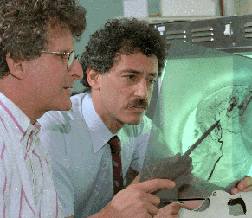

LBL physicist Kenneth Frankel (left) and physician Richard Levy examine a film showing AVMs, brain abnormalities that can be treated with proton beams.
LBL HAS SIGNED A TWO-YEAR AGREEMENT to transfer its heavy-ion radiosurgical technology for treating a deadly brain disorder to Loma Linda University Medical Center's Proton Cancer Treatment Center. The benefit will be to help ease the suffering of patients afflicted with arteriovenous malformations (AVMs), abnormal blood vessels in the brain which can often, without treatment, cause lethal or disabling brain hemorrhages and seizures.
"This agreement will assure that patients with surgically inoperable AVMs will once again have access to heavy-ion radiosurgical treatment, the best available therapy for this potentially life-threatening disorder," says Dr. Richard Levy lead scientist of the heavy-ion radiosurgery program at LBL. The Laboratory's own program was curtailed in 1992 when federal budget cut-backs forced the closure of LBL's Bevatron, the accelerator used to generate the therapeutic beams.
It is estimated that some 300,000 individuals in North America suffer from AVMs. AVM symptoms typically appear before age 40 and occur in otherwise healthy young people.
"Results to date for AVM patients treated at LBL have been excellent," says Levy. "Cure rates greater than 85 percent have been achieved with heavy-ion radiosurgical treatment of small AVMs, and with a low risk of complications."
Patients will now be treated at Loma Linda's specialized facility, which is built around a mini-accelerator. The accelerator generates beams that are transported through a conduit into one of four treatment rooms. Patients rest on a couch with their head secured in an immobilization frame. With millimeter precision the beams are focused on the AVM to obliterate abnormal vessels and remove the risk of future brain hemorrhage. The actual beam treatment lasts just a few minutes. Most patients are able to return to work or other activities immediately after the procedure. For more information about the program contact Dr. Richard Levy at (510) 486-7410.
Return to LBL Research Review Table of Contents